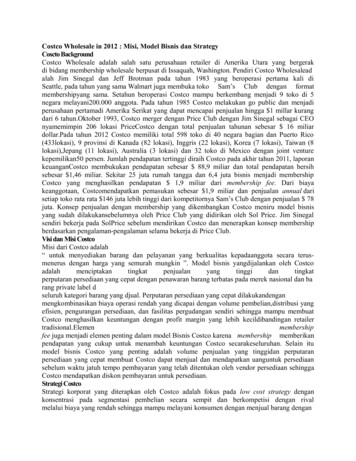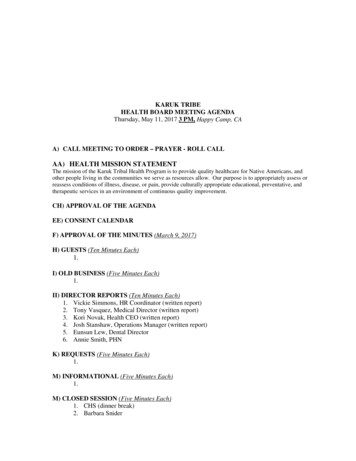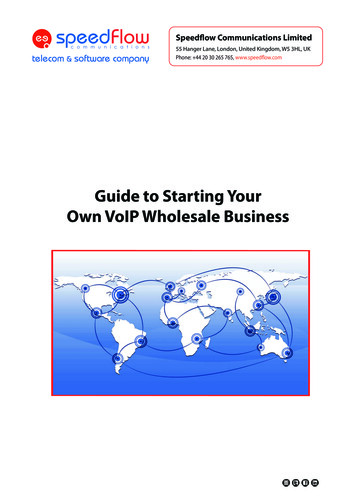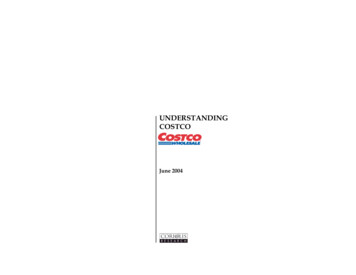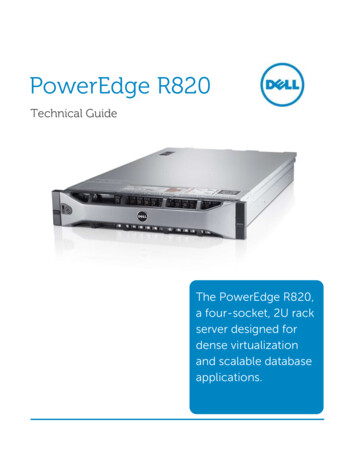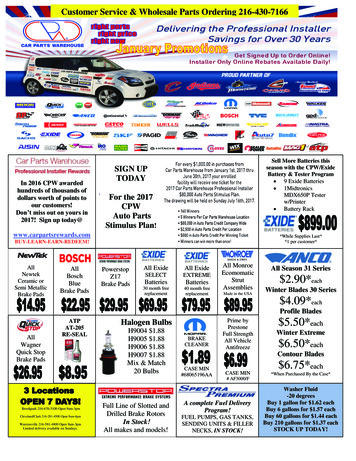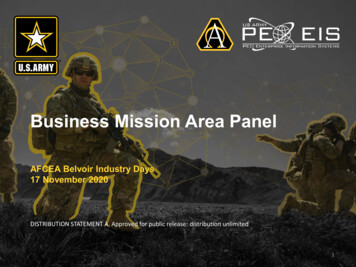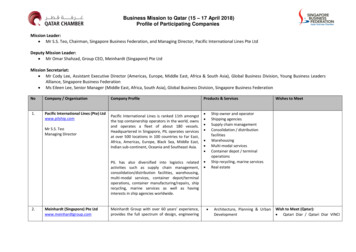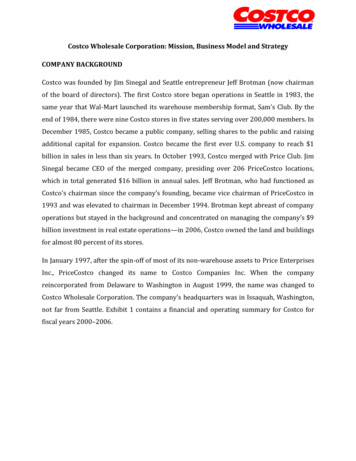
Transcription
Costco Wholesale Corporation: Mission, Business Model and StrategyCOMPANY BACKGROUNDCostco was founded by Jim Sinegal and Seattle entrepreneur Jeff Brotman (now chairmanof the board of directors). The first Costco store began operations in Seattle in 1983, thesame year that Wal-Mart launched its warehouse membership format, Sam’s Club. By theend of 1984, there were nine Costco stores in five states serving over 200,000 members. InDecember 1985, Costco became a public company, selling shares to the public and raisingadditional capital for expansion. Costco became the first ever U.S. company to reach 1billion in sales in less than six years. In October 1993, Costco merged with Price Club. JimSinegal became CEO of the merged company, presiding over 206 PriceCostco locations,which in total generated 16 billion in annual sales. Jeff Brotman, who had functioned asCostco’s chairman since the company’s founding, became vice chairman of PriceCostco in1993 and was elevated to chairman in December 1994. Brotman kept abreast of companyoperations but stayed in the background and concentrated on managing the company’s 9billion investment in real estate operations—in 2006, Costco owned the land and buildingsfor almost 80 percent of its stores.In January 1997, after the spin-off of most of its non-warehouse assets to Price EnterprisesInc., PriceCostco changed its name to Costco Companies Inc. When the companyreincorporated from Delaware to Washington in August 1999, the name was changed toCostco Wholesale Corporation. The company’s headquarters was in Issaquah, Washington,not far from Seattle. Exhibit 1 contains a financial and operating summary for Costco forfiscal years 2000–2006.
COSTCO’S MISSION, BUSINESS MODEL, AND STRATEGYMission: - Costco’s mission in the membership warehouse business read: “To continuallyprovide our members with quality goods and services at the lowest possible prices.”Costco’s StrategyThe cornerstones of Costco’s strategy were low prices, limited selection, and a treasurehunt shopping environment.Pricing: Costco was known for selling top-quality national and regional brands at pricesconsistently below traditional wholesale or retail outlets. The company stocked only thoseitems that could be priced at bargain levels and thus provide members with significant costsavings; this was true even if an item was often requested by customers. A key element ofCostco’s pricing strategy was to cap its markup on brand-name merchandise at 14 percent(Compared to 20 to 50 percent markups at other discounters and many supermarkets).Markups on Costco’s 400 private-label (Kirkland Signature) items could be no higher than15 percent, but the sometimes fractionally higher markups still resulted in KirklandSignature items being priced about 20 percent below comparable name-brand items.Kirkland Signature products—which included juice, cookies, coffee, tires, house wares,luggage, appliances, clothing, and detergent—were designed to be of equal or better qualitythan national brands. Costco’s philosophy was to keep customers coming in to shop bywowing them with low prices. Indeed, Costco’s markups and prices were so low that WallStreet analysts had criticized Costco management for going all out to please customers atthe expense of increasing profits for shareholders. One retailing analyst said, “They couldprobably get more money for a lot of the items they sell.” Sinegal was unimpressed withWall Street calls for Costco to abandon its ultra-low pricing strategy, commenting:“Those people are in the business of making money between now and next Tuesday. We’retrying to build an organization that’s going to be here 50 years from now.”Treasure-Hunt Merchandising: While Costco’s product line consisted of approximately4,000 items, about one-fourth of its product offerings were constantly changing. Costco’smerchandise buyers remained on the lookout to make one-time purchases of items that
would appeal to the company’s clientele and that would sell out quickly. A sizable numberof these items were high-end or name-brand products that carried big price tags—like 2,000– 3,500 big screen HDTVs or 800 leather sofas. The idea was to entice shoppers tospend more than they might otherwise by offering irresistible deals on luxury items.According to Jim Sinegal, “Of that 4,000, about 3,000 can be found on the floor all the time.The other 1,000 are the treasure-hunt stuff that’s always changing. It’s the type of item acustomer knows they better buy because it will not be there next time, like Waterfordcrystal. In many cases, Costco did not obtain its luxury offerings directly from high-endmanufacturers like Calvin Klein or Waterford (who were unlikely to want theirmerchandise marketed at deep discounts at places like Costco); rather, Costco buyerssearched for opportunities to source such items legally on the gray market from otherwholesalers or distressed retailers looking to get rid of excess or slow-selling inventory.Examples of treasure-hunt specials included 800 espresso machines, diamond rings andother jewelry items with price tags of anywhere from 5,000 to 250,000, Italian-madeHathaway shirts priced at 29.99, Movado watches, exotic cheeses, Coach bags, cashmeresports coats, 1,500 digital pianos, and Dom Perignon champagne.Marketing and Advertising: Costco’s low prices and its reputation for treasure-huntshopping made it unnecessary for the company to engage in extensive advertising or salescampaigns. Marketing and promotional activities were generally limited to direct mailprograms promoting selected merchandise to existing members, occasional direct mailmarketing to prospective new members, and special campaigns for new warehouseopenings. For new warehouse openings, marketing teams personally contacted businessesin the area that were potential wholesale members; these contacts were supplementedwith direct mailings during the period immediately prior to opening. Management believedthat its emphasis on direct mail advertising kept its marketing expenses low relative tothose at typical retailers, discounter, and supermarkets.Growth Strategy: In recent years, Costco had opened an average 20–25 locations annually;most were in the United States, but expansion was under way internationally as well. Thecompany opened 68 new warehouses in the United States in fiscal years 2002–2006; 16new warehouses opened in the first four months of fiscal 2007 (between September 1 and
December 31, 2006), and management planned to open another 20–24 by the end of fiscal2007. Five new warehouses were opened outside the United States in fiscal 2005, five morewere opened in fiscal 2006, and four were opened in the first four months of fiscal 2007.Going into 2007, Costco had a total of 102 wholly-owned warehouses in operation outsidethe United States, including 70 in Canada, 18 in the United Kingdom, 5 in Korea, 5 in Japan,and 4 in Taiwan. Costco was a 50–50 partner in a venture to operate 30 Costco warehousesin Mexico. Exhibit 2 shows a breakdown of Costco’s geographic operations for fiscal years2003–2006. (The data for the 30 warehouses in Mexico are not included in the exhibitbecause the 50–50 venture in Mexico was accounted for using the equity method.)Web Site Sales: Costco operated two Web sites— www.costco.com in the United States andwww.costco.ca in Canada—both to provide another shopping alternative for members andto provide members with a way to purchase products and services that might not beavailable at the warehouse where they customarily shopped, especially such services asdigital photo processing, prescription fulfillment, and travel and other membershipservices.Warehouse Operations: Costco warehouses averaged 140,000 square feet and wereconstructed inexpensively with concrete floors. Because shoppers were attractedprincipally by Costco’s low prices, its warehouses were rarely located on prime commercialreal estate sites. Merchandise was generally stored on racks above the sales floor anddisplayed on pallets containing large quantities of each item, thereby reducing laborrequired for handling and stocking. In effect, warehouse managers functioned asentrepreneurs running their own retail operation. They were responsible for coming upwith new ideas about what items would sell in their stores, effectively merchandising theever-changing lineup of treasure-hunt products, and orchestrating in-store productlocations and displays to maximize sales and quick turnover. Costco had direct buyingrelationships with many producers of national brand-name merchandise (including Canon,Casio, Coca-Cola, Colgate-Palmolive, Dell, Fuji, Hewlett-Packard, Kimberly-Clark, Kodak,Levi Strauss, Michelin, Nestlé, Panasonic, Procter & Gamble, Samsung, Sony, Kitchen Aid,and Jones of New York) and with manufacturers that supplied its Kirkland Signatureproducts. No one manufacturer supplied a signify cant percentage of the merchandise that
Costco stocked. Costco had not experienced any difficulty in obtaining sufficient quantitiesof merchandise, and management believed that if one or more of its current sources ofsupply became unavailable, the company could switch its purchases to alternativemanufacturers without experiencing a substantial disruption of its business. Costcowarehouses accepted cash, checks, most debit cards, American Express, and a private labelCostco credit card. Costco accepted merchandise returns when members were dissatisfiedwith their purchases. Losses associated with dishonored checks were minimal because anymember whose check had been dishonored was prevented from paying by check or cashinga check at the point of sale until restitution was made.Business Model: - The Company’s business model was to generate high sales volumes andrapid inventory turnover by offering members low prices on a limited selection ofnationally branded and selected private label products in a wide range of merchandisecategories. Management believed that rapid inventory turnover—when combined with theoperating efficiencies achieved by volume purchasing, efficient distribution, and reducedhandling of merchandise in no-frills, self-service warehouse facilities—enabled Costco tooperate profitably at significantly lower gross margins than traditional wholesalers, massmerchandisers, supermarkets, and supercenters.Financial Perspective:*** given data from case studyFinancial Measure200620052004gross profit margin10.5% 10.6% 10.7%return on stockholder equity 5.6%11.1% 11.4%current ratio1.051.221.18debt to equity ratio0.020.090.13inventory turnover11.4211.4511.41working capital (in millions)41314771099The gross profit margin falls into the normal range for this industry. However, it should betrending upward and as you can see it is actually decreasing slightly. If this trend continues,steps will need to be taken to correct the problem. Another probability indicator, return onstockholder equity indicates that the company has a problem. Average returns are around
12%, which Costco was nearing in 2004 and 2005. In 2006, the company experienced asharp decline which is cause for concern. Investigate this decline. It could be due to lowprofits after taxes. If the pricing is too low, this can happen. Currently, Sinegal, admittedly,tries to sell products at the lowest price possible for longevity.However, if the investors in the firm are not making appropriate returns for the risk, theywill invest elsewhere. The current ratio figure is in the average range but on the decline.The debt to equity shows a strong balance sheet and low levels of debt. It is trendingdownward. The inventory turnover rate is slightly higher than average, indicating thatCostco is outperforming competitors in moving product. Also cause for concern is the factthat the working capital is shrinking. This might indicate the inability to expand without aloan.Costco’s Membership Base and Member DemographicsGOALS TOWARDS MEMEBERS: Take Care of our Members Provide quality products at the best prices 100% satisfactions guarantee warranty on every product & membership fee. Provide ecologically sensitive products Provide the best customer service in the retail industry Give back to our community through volunteerism and corporate contributionsCOMPENSATION & WORKFORCE:Compensation and Workforce Practices: “Our employees are our most important asset; theyare the key to executing the strategy successfully.” –SinegalProvide Competitive Wages Starting hourly wage: 12; Average hourly wage: 17-18Generous BenefitsCareer Opportunities: Policy that 86% of higher lever openings are hired from within.In actuality, the figure runs at 98%.Open Door Policy-that allows ascending levels of management to resolve issues.
Executive compensation: Salary-roughly 12 times of a person working the sales floor plusStock Options and BonusesResults of Taking Care of Employees:120,000 employees spreading a positive message about CostcoHigh employee retention (6% turnover rate)Higher productivity from workersCostco’s Business Philosophy, Values, and Code of EthicsCostco’s corporate culture and the manner in which the company operated values,principles and operating approaches are the following excerpts:Goals:1. Obey the Law2. Take Care of Members3. Take Care of our Employees4. Respect our Suppliers5. Reward our ShareholdersCompetitor Analysis:Primary Competition:1. Sam’s Club2. BJ’s wholesaleFactors of Competition:Price, merchandise quality, location& membership services
Secondary Competition:1. Retail Discounters: Wal-Mart & Dollar General2. General Merchandise Chains: Target & Kohls3. Low-Cost Specialty Stores: Lowe’s, Home Depot, Staples, Best Buy, Circuit City, Barnes &NobleCompetitive OutlookCostco is beating both Sam’s Club and BJ’s wholesale in net sales and market share.However, Sam’s Club has launched an aggressive campaign that its product offering isnearly twice as large. Costco’s overseas performance is mixed. The last four years, ther
COSTCO’S MISSION, BUSINESS MODEL, AND STRATEGY Mission: - Costco’s mission in the membership warehouse business read: “To continually provide our members with quality goods and services at the lowest possible prices.” Costco’s Strategy The cornerstones of Costco’s strategy were low prices, limited selection, and a treasure-

